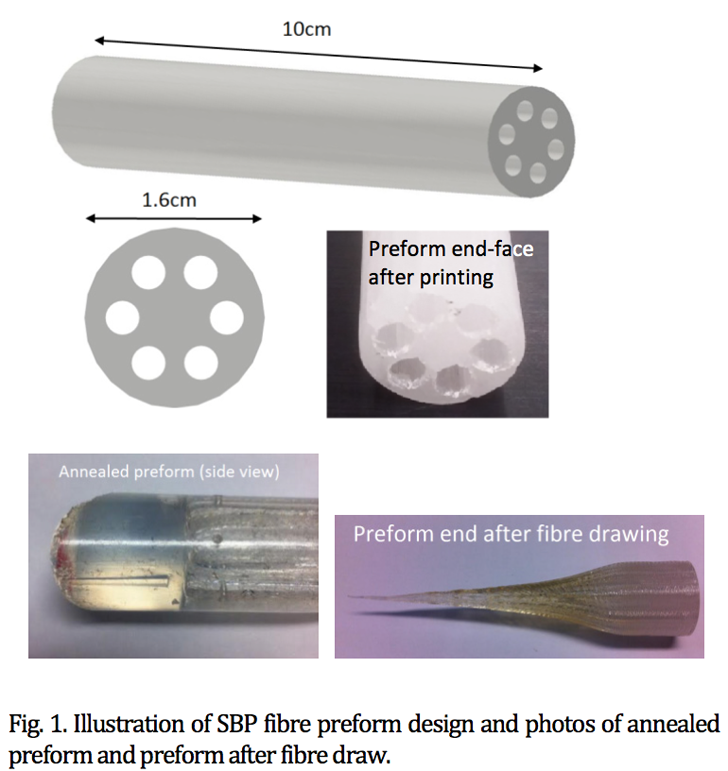Recently, we covered some exciting research being pursued by the University of Southampton relating to the use of 3D printing for the creation of uniquely shaped fiber optics. Though their technique will likely involve the selective laser sintering of pure glass powder, it has been brought to my attention by one 3DPI reader that Southampton’s project is not the first to unite 3D printing and fiber optics. In fact, a team of researchers at the University of Sydney may have been the first to create fiber optics with 3D printing.
From the video below, you’ll see that the process for creating optic fibers is a tedious, expensive, and time-intensive one. To create a single fiber, a long glass tube is heated to the point that silica and germanium particles are formed within, eventually forming a preform. This preform is then placed vertically in a specialized heating mechanism that allows the glass to drip into a very fine thread. The thread is then weighted, slowly stretching the fiber to its desired thinness. Finally, to create a fiber optic cable, which communicates data via light, these individual fibers are stacked together in a hexagonal pattern. All of this, as you can imagine, limits the shape of a fiber optic cable, but the material, too, is limited. To reduce the cost and labor and increase the possible geometries and usable materials, optics researchers are exploring new methods of fabricating fiber optics. The University of Sydney has turned to 3D printing.
In the University of Sydney study, accepted for publication by the journal OSA Optics Letters, the team of researchers actually implements FDM 3D printing to create a new preforms from which to draw the optic fibers. Led by Prof. John Canning, of the university’s interdisciplinary Photonics Laboratories (iPL), the team first designed the preform in Autodesk Inventor and then 3D printed it on a Redback-2 3D printer from Aussie manufacturer Deltastine. As the researchers were dealing with optics, the material had to be chosen carefully, so they opted for a commercially available transparent filament they call SBP, a modified ABS made from styrene-butadiene-copolymer and polystyrene. As stated in the OSA paper, the reason for SBP was its transparency, flexibility, and lack of discoloration when contorted.

The preform was then drawn into a thin optical fiber using a computerized drawing tower. Though the team had a few bumps to the novelty of the material, having never made an optical fiber with SBP before, the results are amazing. Choosing an arbitrary design for the preform, a solid core surrounded by six tubular holes, their initial print was 1.6 cm in diameter and 10 cm long. After the drawing, however, their fiber, after drawing, was just 712 microns on one axis and 605 on the other (the fiber had an elliptical shape due to some issues with the print settings and materials). More importantly, that same shape was maintained even at this tiny level and light was able to pass through it at the transmission band for telecommunications. In other words, it was possible to 3D print a uniquely-shaped fiber optic cable for possible use in telecommunications.

This being just the first instance of a 3D printed fiber optic, there is, of course, a lot of work to be done, including refining the settings of the printer and nailing down the exact drawing temperature necessary for stretching the SBP. And, what’s even more exciting, is the possible geometries that could be eventually formed and their possible uses. The study itself describes the potential to use 3D printed optics made from plastics in medical devices, such as low-cost attenuation sensors to monitor dental orthodontic pain.
I asked Prof. Canning what sorts of geometries he imagined creating and, immediately, Fresnel lens designs – a ridged shape already achieved by LUXeXcel’s optical 3D printing – came to mind. “In terms of future geometries,” Prof. Canning explained, “the fantastic thing about 3D printing is that you can, in principle, make any geometry – this has been a major challenge. Normally in polymer, one would drill holes using a CNC mill but that is not perfect. Typically for periodic structures, such as in photonic crystal fibres, stacking of capillaries is undertaken but this limits structures to periodic ones – for 2D cross-sections of optical fibres the best confinement solutions are not periodic but quasiperiodic such as those based on Fresnel fibres. We were the first to introduce drilling and we did so ironically in silica in order to make the first Fresnel fibre – it took ten hours to drill a pattern 5 cm long without cracking a preform.”

Prof. Canning went on to point out that glass 3D printing, which is already being pursued by Micron3DP, would completely change the way fiber optics are produced, “It was immediately obvious to me that 3D printing in glass is needed badly and our article, despite using very low cost fused deposition in polymer, which limits resolution and hole size (as a scientist one has to work within the available budget), clearly shows why it will revolutionise manufacture (even for solid core fibres) especially when glass printers come on line – I think 3D printing brings an incredibly exciting future for fibre research and fibre fabrication.”
In the study, the authors indicate that laser sintering, as being pursued by Southampton, could improve the resolution of their prints significantly and that Carbon3D’s CLIP technology would help them tackle the speed issue, with their print requiring six hours of printing time. I can also imagine them ordering a print from LUXeXcel to test out. Regardless of what they try next, they may be able to bring light-based communication to us even faster. And, from Prof. Canning’s conclusion, it sounds like they’ve already got something in the works, “We are in fact working on some novel variations that we hope to publish soon.”


